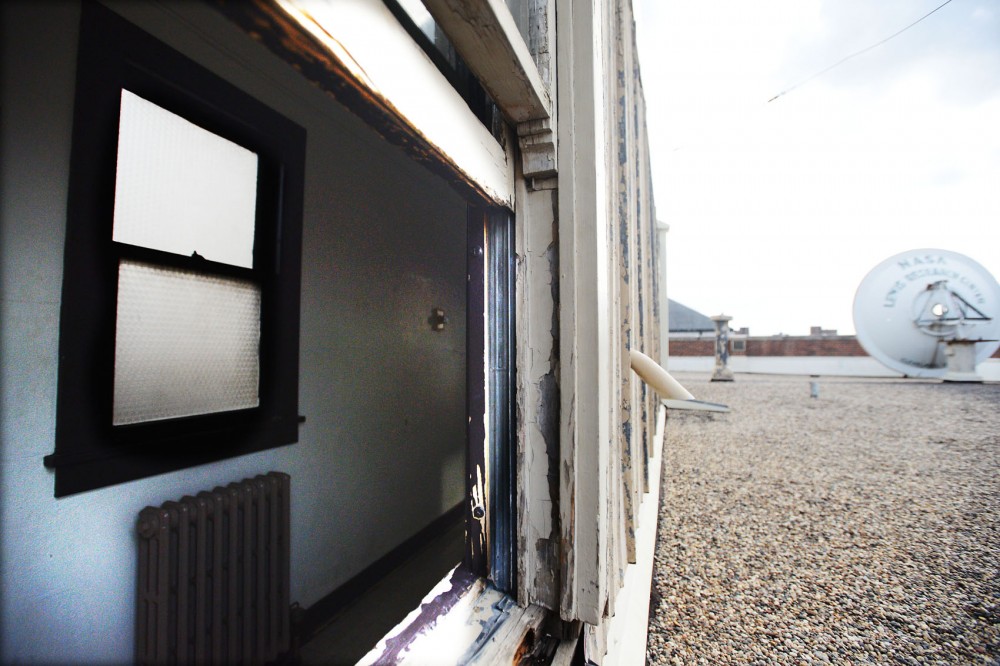In the Tate Laboratory of Physics, students sit on the ground as they study and prepare for classes. Many ceiling tiles are broken and moldy, lighting fixtures are cracked and window frames are rotten.
University of Minnesota faculty and students agree it’s time for a renovation.
The state Legislature didn’t approve funding for improvements to Tate Lab last session. But the Board of Regents approved the University’s 2014 Capital Request on Oct. 11, which asks the state for nearly $233 million to fund improvements to Tate and five other campus building and renovation projects.
The Tate Lab renovation is projected to cost $85 million in total, with $56.7 million requested from the state.
The proposed projects on the Twin Cities campus would improve some labs and build new ones. Listed potential projects include the Bee Lab, the College of Biological Sciences Greenhouse and a brand-new Microbial Sciences Research Building.
Tate renovation
If the Legislature approves funding for Tate’s restoration, the building would be completely restructured to add more study spaces and conference rooms, improve handicap accessibility, replace all of the decaying windows and upgrade electricity and utilities, said physics and astronomy department head Ron Poling.
“They haven’t done anything about the roof,” he said. “It still leaks every few years.”
Laboratory machinist specialist George Derks, who’s worked in Tate for more than 30 years, said he thinks renovation is long overdue. The University hasn’t renovated the building since the 1990s, Poling said.
“Right now, when I install air conditioning upstairs … they blow the circuit breakers,” Derks said.
Astrophysics professor Paul Woodward said he’d like to see more modern projectors for larger classrooms and lecture halls.
Biology freshman Cassandra Longtin said she’d like to see the building’s stairs renovated because she can only use the staircase on one side to get to her physics lab on the fourth floor.
She’d also like to see improvements to restrooms.
“The bathrooms have an awkward setup,” she said. “There isn’t room for people to line up, and the stalls could always be newer.”
The University will preserve Tate’s historic exterior while remodeling the interior, Poling said. Changes could include adding a student lounge, an entrance on Church Street Southeast, more energy-efficient windows and a centralized utility system.
“I think it’s pretty much going to be gutted,” he said.
A new microbial building
On the University’s St. Paul campus, a Microbial Sciences Research Building could replace two outdated facilities.
If it receives its requested $30 million in state funding, the new building will function as an interdisciplinary research space for 30 to 35 researchers in non-medical microbiology fields.
Plant pathology professor Nevin Young said the new building will likely have better gathering spaces and more opportunities for microbiologists from different departments to collaborate.
Faculty members and researchers currently have their offices and labs in their respective departments, Young said. But with the new building, they would have to relocate.
“The benefit is it will be new, sexy, up-to-date space … The disadvantage is all these departments are more dispersed,” Young said. “It will be a step forward for everybody, that’s for sure.”
Although it may be difficult for relocated individuals to keep in touch with colleagues, biochemistry, molecular biology and biophysics professor Romas Kazlauskas said the building could create a new community.
“It’s really a powerful thing when you can put people with different backgrounds and different research ideas right next to one another,” he said. “It can be a big advantage.”
Other restorations
In the St. Paul campus’ Bee Lab, mice often fall into toilets in the bathrooms because the ceiling is decaying.
The foundation of the CBS Greenhouse is collapsing, and about 60 windows break each year because they’re made of single-pane glass.
Assistant plant biology scientist Jodi Kipping-Bjork said holes in the structure’s foundation are so large that woodchucks often sneak in.
The Bee Lab and the greenhouses could be part of the $12 million in requested state funding for laboratory improvement on campus.
“The actual physical structure is the biggest problem,” Kipping-Bjork said. “The cement [foundation] is literally crumbling. We patch it and repair it each summer.”
Renovations would cost more than scrapping the entire building, she said, so the department hopes to start over and build new.
The Bee Lab also hopes to rebuild, entomology professor Marla Spivak said.
“We’ve outgrown the space,” she said. “We’re running the whole ship out of the garage, and it’s falling down.”
Spivak said she expects the lab renovation will receive funding this spring. If it does, she’d be willing to relocate anywhere to get construction started.
“We’re ready to break ground in July,” she said. “I’ll pitch a tent — anything to get a new lab.”


